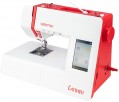Number of stitches
The number of stitches that a sewing machine can sew. The larger this number, the more extensive the capabilities of this model, the wider the choice the user has; however, it wouldn’t hurt to clarify the specific range of supported stitches separately.
The fewest options - mostly up to 25 - are provided in electromechanical machines, as well as specialized devices such as overlockers and carpet lockers (see “Type”). In computer-controlled devices, the number of lines can be in the dozens, and some also allow you to download additional options from the computer.
Number of loops
The number of welt stitches that a sewing machine can make. Different types of loops are used for different types of fabrics and clothing. The larger this number, the wider the choice the user has and the less likely it is that the machine’s arsenal will not have the required type of loop.
Max. stitch length
The maximum stitch length that the sewing machine can sew. This parameter is important for working with dense thick fabrics: the stronger the fabric, the longer the seam used for it. Accordingly, the longer the stitch (
5 mm or more), the better the machine is suitable for working with similar fabrics.
Max. stitch width
The maximum stitch width provided by a sewing machine.
Most modern sewing machines are capable of working not only with the simplest longitudinal seam (when punctures with a needle occur strictly one after another), but also with seams that cover a certain width - for example, zigzag and various decorative ones. And in overlockers, such opportunities are generally available by definition.
The larger the maximum stitch width, the correspondingly wider the machine’s ability to work with specific types of seams (all other things being equal). An indicator of up to 5 mm is typical mainly for entry-level devices, 5 - 7 mm - average, 7 mm and more - advanced.
Sewing speed
The maximum sewing speed provided by the sewing machine. In the vast majority of models, this parameter can be adjusted, so if necessary, you can sew at a lower speed.
The more stitches a machine makes per minute, the higher its productivity, the better suited it is for large volumes of work. At the same time, it is worth considering that high speed has a corresponding impact on price and energy consumption, and it is not always required. Detailed recommendations on choosing the optimal speed for certain types of work can be found in special sources.
Adjustments
—
Регулировка давления лапки. Возможность изменять степень давления лапки на ткань, подстраивая ее под толщину материала: для тонких тканей (шифон, трикотаж) давление должно быть небольшим, для толстых — наоборот.
—
Регулятор натяжения нити. Приспособление, позволяющее регулировать степень натяжения верхней нити. Несогласование по натяжению между верхней и нижней нитью приводит к тому, что одна из ниток вытягивает другую и шов портится; для избежания этого явления и предусматривается данная функция. Отметим, что регулировка натяжения возможна и для нижней нити — она осуществляется через челнок (такую возможность имеют все челноки). Но для этого необходимо вынимать шпульный колпачок, а то и весь челнок целиком. Верхний же регулятор располагается прямо на корпусе машинки, и пользоваться им значительно проще.
—
Стабилизатор усилия прокола. Приспособление, которое обеспечивает стабильное усилие прокола независимо от скорости работы двигателя. Особенность механики электродвигателей заключается в том, что без специальной регулировки усилие прокола заметно снижается при росте оборотов. Данная же функция позволяет поддерживать приблизительно одинаковый уровень на всем диапазоне скоростей, что положительно сказывается на качестве работы.
—
Отключение нижнего транспортера. Возможность отключить нижний транспортер машинки. Д
...анная особенность незаменима для работ, при которых ткань нужно смещать вручную — например, вышивки по сложному контуру на машинке без вышивального блока, пришивании пуговиц и т.п.
— Ограничитель скорости. Возможность задать ограничение по скорости работы машинки. Благодаря этой функции можно не бояться «пережать» педаль — даже при сильном нажиме машинка будет работать с заданной скоростью, и не быстрее. Данная особенность бывает полезна, в частности, при работах, где требуется внимательно контролировать процесс.
— Коленный рычаг подъема лапки. Приспособление, позволяющее поднимать лапку и опускать нижний транспортер движением колена, не снимая рук с ткани. Такое приспособление бывает полезно при квилтинге и некоторых разновидностях вышивки.Embroidery unit
Наличие в машинке вышивального блока — дополнительного приспособления в виде платформы с пяльцами, которые способны двигаться под иглой в разные стороны. В соответствии с названием, такой блок позволяет в автоматическом режиме вышивать различные узоры и рисунки.
Max. embroidery area
Максимальный размер области, которую машинка в режиме вышивания может обработать за один раз, без перенатягивания ткани на пяльцы. Иными словами, это максимальный размер рисунка, который устройство может вышить «за один заход».
Смысл данного параметра очевиден: он позволяет оценить, подойдёт ли выбранная модель для вышивки рисунков запланированного размера.
Number of embroidery patterns
The number of embroidery patterns supported by the machine.
In this case, usually, it means the number of drawings that can be simultaneously written to the device's memory and stored there. The more diverse the planned embroidery work, the more memory is desirable for them. However, in modern models, the number of drawings often reaches several dozen.

